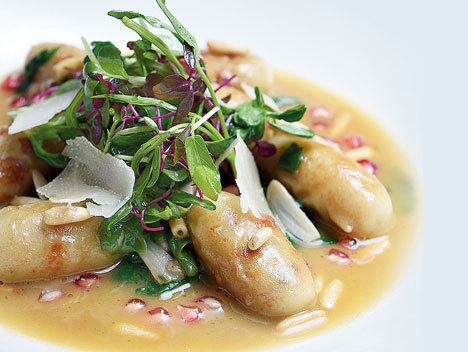MICRO GREENS

Melt-in-the-mouth potato gnocchi meets the freshness of cauliflower, kolmi and laal saag micro greens along with the crunch of pine nuts. The yummy and light brown butter holds the dish together. Rs 550-plus
.jpg)


What are micro greens? The first shoots of vegetables such as beetroot, spinach and cauliflower. Previously used as embellishments on dishes, these rich sources of fibre have made it big in the culinary world and have evolved beyond mere garnishes. “For us, the use of micro greens is not limited to the scope of ornamentation. Calcutta and West Bengal per se has a lot of indigenous flavours in the form of saag. We love our kolmi saag, our laal saag, our mulo daata and the list goes on. At The Salt House, we try and source these saags as micro greens and pair them with different dishes. Our effort is to try and use these micro greens in place of regular leaves such as rocket or arugula. For example, baby mulo saag can easily replace arugula, and the best part is that it is much sweeter and fresher,” said chef Auroni Mookerjee of The Salt House.

HOW TO USE MICRO GREENS
1. You can pair micro greens with any and every kind of food, be it a salad or a sandwich.
2. Do not cook it. Add it to the dish once you have taken it off the flame and the latent heat from the dish is enough to cook it.
3. The trick is to try and balance the flavour of the micro greens with other ingredients. For example, you can pair spicy dishes with tart ones such as kolmi saag micro greens.
4. Serve it as fresh as you can, else the flavour and crunch are lost.
EDAMAME

Most popularly used in dumplings, edamame as an ingredient, especially in Asian cuisine, has hit it big time. But did you know that the term edamame refers more to the preparation than the vegetable? Young soy bean pods when steamed with salt turn into what we commonly refer to as edamame. “Edamame are soy beans in the pod, very commonly used in South- east Asian cuisine. The popularity of edamame is growing worldwide because it’s easy to cook, has nutritional benefits and is delicious. It blends well with most Asian dishes and adds texture,” said Prashanth Puttaswamy, executive chef, The Fatty Bao. t2 checked out these edamame specials.






LOTUS STEM

Another ingredient that has found favour with foodies is the lotus root. From being a popular finger food to a healthy addition in salads, it has been adapted in many ways.

“Lotus root has always been held in high esteem in China; it has been a part of their diet for centuries. Its appearance is eye-catching and its texture has the ability to blend with any flavour you add to your dish. Not only the root but every part of the lotus plant — flower, stalk, leaf and seeds — are used,” says chef Kushal Lama, head chef, Yauatcha, Calcutta. Here are a few of our lotus root faves in the city.



BROCCOLI

The broccoli is a vegetable that most moms love feeding their kids, while the children tend to run away from it. However, this super healthy vegetable is now being used in different ways that are breaking the myth about it not being good to taste. “Broccoli is a cruciferous vegetable, known to be a cancer fighter due to its high content of sulphoraphane. This also makes it a vegetable with a high detox potential. The Vitamin K in it makes it good for your bones too. It is also a good source of Vitamin C, making it a great immunity booster,” says restaurateur and nutritionist Hena Nafis. t2 tried a few broccoli dishes.






WATER CHESTNUT

Who would have known that the humble paani phal or water chestnut could be used in such fancy forms?! From Thai desserts to exotic prawn curries, water chestnuts have found their way into the culinary scheme of things and looks like they’re here to stay.

“The water chestnut’s brownish-black paper-like skin resembles that of a chestnut, but its flesh is white, crunchy and juicy. The flavour is bland with a hint of sweetness. These are a staple in Chinese cooking. Perhaps the biggest selling point of water chestnuts is that they remain crunchy when cooked or canned, so they add a nice texture to a dish. Water chestnuts can keep you full longer while supplying your meals with vitamins and minerals. It has no cholesterol and is low in sodium and fat. The zero fat content may help you prevent weight gain when adding them to your diet. Try adding them to salads, soups, wraps or even pizza toppings,” said Janti Dugal, food director, Mamagoto, Azure Hospitality Pvt. Ltd.



Text: Zeba Akhtar. Pictures: B. Halder











